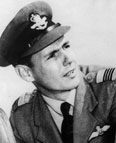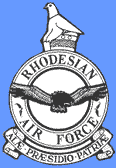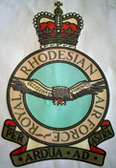Air Force Home Page 1 Squadron Home Page
1 Squadron Home Page Site Home Page
Site Home Page
Formation Accident FB9 6th May 1959
An account by Peter Petter-Bowyer
 After the first Canberras arrived, No 1 Squadron was preparing a formation aerobatic team to participate at the "Elizabethville Air Show". The reason for the Belgian invitation to our Air Force to participate in their great show at Elizabethville in the Katanga Province of the Congo is lost to me. Nevertheless the Vampires were to put on a formation aerobatics display and the newly acquired Canberras were to give solo and formation demonstrations.
After the first Canberras arrived, No 1 Squadron was preparing a formation aerobatic team to participate at the "Elizabethville Air Show". The reason for the Belgian invitation to our Air Force to participate in their great show at Elizabethville in the Katanga Province of the Congo is lost to me. Nevertheless the Vampires were to put on a formation aerobatics display and the newly acquired Canberras were to give solo and formation demonstrations.
As Squadron Commander, Colin Graves led a formation team of four aircraft with Mike Reynolds No 2, Peter McClurg No 3, and Randy du Rand No 4. The team was reduced to four because of Vampire power limitations (Ground height 6,000 ft).
Colin had taken his team out into the flying area for some days before he felt ready to come to the airfield to have his prepared sequence viewed and evaluated. The results were pleasing and we all felt good about having such a team to show off Rhodesian talent. Most Air Forces around the world boasted national aerobatics teams of which the Black Arrows team (Hunters) of the RAF was closest to us by association.
However, there was an enormous gap between handling demands on pilots flying formation aerobatics on Hunters and those doing the same in Vampires. The Vampire's power margins were really too small and engine response too slow for formation aerobatics, placing unusually high demands on pilots to hold a steady station in all manoeuvres. Typically a jet suited to formation aerobatics would have at least 25% power reserve and rapid response engines. The Vampire at best had 10% reserve with relatively poor thrust response to throttle.
The old Control Tower, soon to be demolished, incorporated an outside balcony that served as a perfect place from which to watch Colin's team go through its routines. Together with others, I was on this balcony on 6 May 1959 waiting for another in a series of display practices when I happened to notice that Wing Commander Wilson was joining us.
Colin had completed a barrel roll running across our front from east to west before leading the formation in a long sweeping climb to starboard during which the aircraft, all FB9s, changed from finger four to box formation. In this pattern and still in the turn, the formation kept coming around descending to gain speed for a loop directly in front of us.
Before the aircraft reached the top of the loop Randy du Rand, as No 4, had fallen back two aircraft lengths from his correct position. Immediately Wing Commander Wilson crossed the platform at a run and went racing off down the stairway. Most of us saw this out of the corner of the eye but thought nothing of it because our attention was focused on the formation.
In the descent Randy's aircraft moved forward but overshot slightly, his nose coming under the leader’s tail plane as the formation swept through the bottom of the loop. As the aircraft pitched into the climb Colin's aircraft dropped in turbulence and his tail plane was removed as it smashed through Randy's canopy. This created a shower of flashing debris that seemed to stop dead in mid-air with the aircraft passing on. Without its tail plane, Colin's aircraft pitched down from its shallow climb into a shallow dive then rolled inverted and disappeared from view behind a line of gum trees on Thornhill's western boundary. A huge angry red fireball enveloped in black smoke rose into view a couple of seconds later.
We were staring in disbelief when I pointed to Wing Commander Wilson's speeding staff car. How he had sensed what was coming we could not say but from the start he had been heading directly for the crash site.
That the much loved and respected Colin Graves was dead there could be no doubt and one was left wondering how the decision not to fit life-saving ejector seats could be justified on the basis of high costs. Compared to the loss of this experienced officer and father of two young children it seemed such a petty issue. But then our attention was drawn from the tragedy to a new situation.
Randy, though still flying, was in mortal danger. The impact with Colin's tail plane had shattered his canopy. The thick armoured glass of his windscreen, still encased in its battered frame, had been pushed past the gunsight and lay across Randy's arms fully exposing his head and upper body to high-speed airflow. This might have been tolerable had the visor on Randy's helmet not been shattered too. Fortunately his oxygen mask was still in place and prevented him from an air drowning.
With blood being driven into his eyes by the airflow, Randy could not see a thing. Fortunately he did not lose consciousness, his mask and earphones continued to function and he could still move throttle and control column. Peter McLurg had seen the collision right next to him but instantly lost Colin's aircraft when it pitched out of sight. Like Mike Reynolds, Peter moved away slightly but he kept his eye on Randy whose aircraft was climbing.
Peter knew that Colin had ploughed in and, closing his mind to this horror, switched his full attention to Randy who reported that he was blind. Peter moved in and became Randy's eyes by calling his climb angle and telling him which way to roll to keep wings level. Holding formation on Randy, Peter asked him to start throttling back and continued informing Randy of his flight attitude, speed and engine rpm.
Randy considered bailing out but Peter McLurg insisted he was safer where he was and assured Randy he would guide him in for a safe landing. After discussion, Randy agreed that a wheels-up landing on the large open expanses of cut grass was safer than attempting to bail out or risking a blind landing on the relatively narrow tarmac runway. By this time Randy, now flying at reduced speed, could see just enough to hold formation on Peter.
All attention was on the two dots descending towards the airfield. Anyone not knowing of the drama in the air would not have guessed that the pilot of one aircraft could hardly see. Everything looked normal except for the fact that the aircraft were not aligned with the main runway. On short finals Randy's descent suddenly increased towards high tension power lines running between the railway and the airfield boundary fence. He responded to Peter's urgent "Pull up - check - hold it - descend - close throttle - start rounding out - a bit more - touch down now!"
Peter McLurg was overshooting as Randy's aircraft bellied onto the grass. High friction pitched the aircraft nose down lifting the tail so high it remained visible above flying debris and a great cloud of red dust. Having travelled about 200 metres, the aircraft went into a slow turn and was lost to view in dust before it came to rest facing back along the line of torn-up grass. A staff car seen tearing across the grass paddock from the Tower disappeared into the dust cloud. When it cleared we could see Randy being helped out of his wrecked cockpit by the one and only Mac Geeringh; ever ready to help anyone in trouble.
An inspection of the crash site suggested that Colin had deliberately rolled his stricken aircraft to avoid crashing into a particular house. The engine had buried itself into the ground but three of the 20mm cannons broke loose and somersaulted ahead of airframe wreckage. In another house, a Rhodesian Railways man was fast asleep in his bed having come off night duty. He was awakened by the loud noise of one cannon smashing through his window and driving sideways through a large wardrobe. It had passed just a couple of inches above his body. Two other cannons passed either side of the man's two small children who were playing in the driveway. These came to rest at the back of his garage, one each side of his unscathed car. These were lucky people but Colin was not the only casualty that day. An old man seeking to give assistance died of a heart attack before reaching the crash site.
Prior to the accident, a routine medical examination showed that one of Randy’s eyes had become weaker than the other, but not to the extent that he could not pass the compulsory six-monthly flying fitness test. When he had fully recovered from the accident, it was established that the bang he had received on his head might have been the reason his faulty eye had returned to normal.
Following the death of Colin we received a new squadron commander. Squadron Leader Sandy Mutch’s posting to No 1 Squadron brought our OC's rank into line with the other squadrons. He immediately took leadership of Colin’s aerobatics team and had it ready in time for the ‘Elizabethville Show’.



















